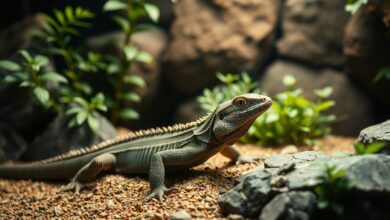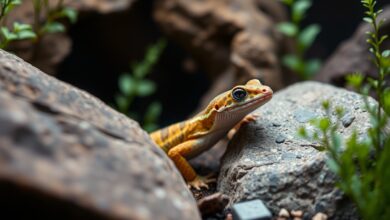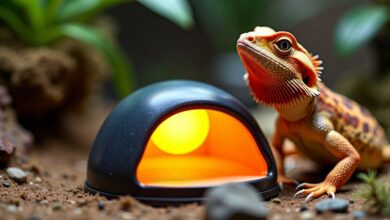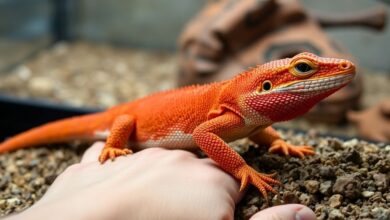
Many reptile enthusiasts are captivated by the unique beauty of baby albino iguanas, making them a popular pet choice. In this complete care guide, you will learn about their specific habitat needs, dietary requirements, and how to maintain their overall health. You’ll also discover fascinating facts that highlight their gentle temperament and the importance of UVB lighting for their well-being. Prepare to provide the best care for your new companion and keep your baby albino iguana thriving for years to come!
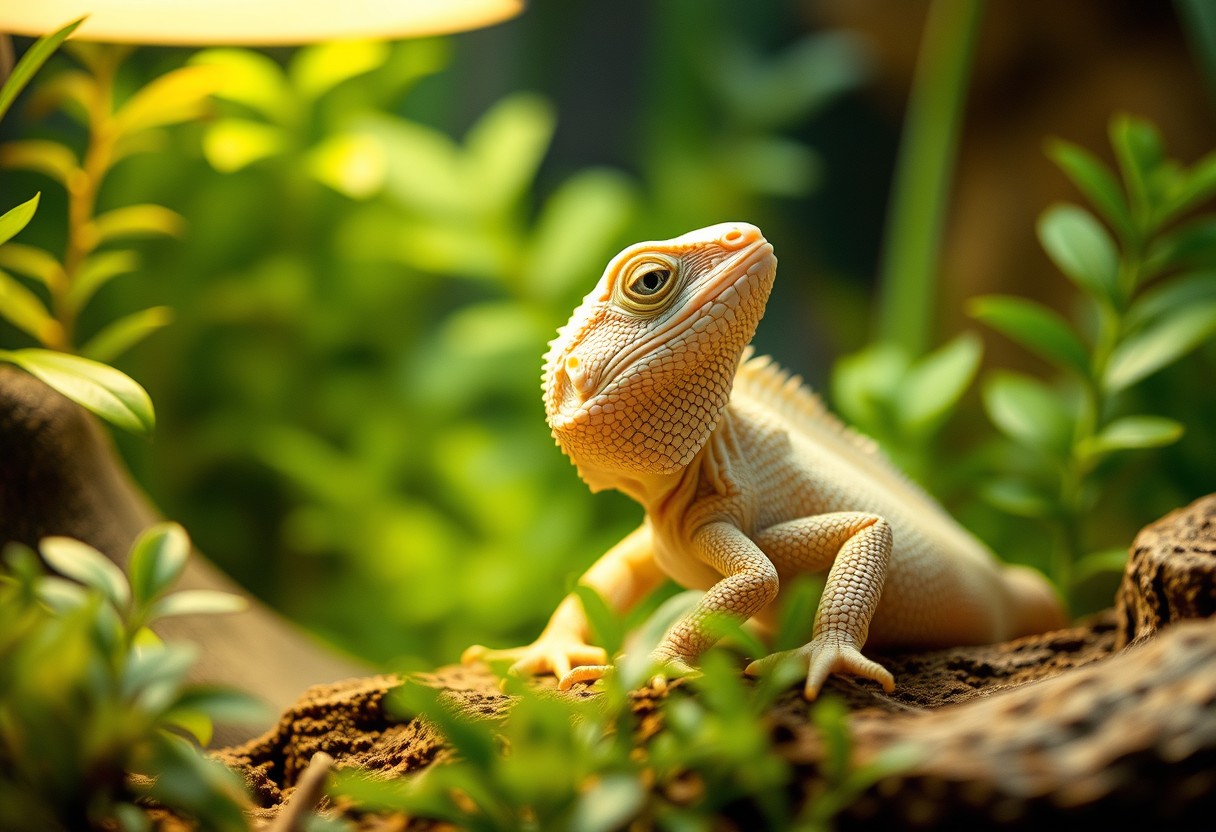
Key Takeaways:
- Care Requirements: Baby albino iguanas need a consistent environment with specific temperature, humidity, and UVB lighting for optimal growth and health.
- Diet: A balanced diet rich in leafy greens and some fruits is important to provide necessary nutrients and avoid health issues.
- Social Interaction: These iguanas are social creatures that benefit from regular handling and interaction to become tame and comfortable with their owners.
Types of Baby Albino Iguanas
To understand the diversity within the baby albino iguanas, it’s vital to recognize the different types of these extraordinary reptiles. Each type features unique characteristics and care requirements. Here’s a breakdown of some notable types:
| Type | Description |
| Lucent White | Exhibits a pure, stunning white color with orange hues. |
| Yellow Albino | Displays bright yellow tones with subtle orange pigments. |
| Pink Albino | Features soft pink shades that can vary across individuals. |
| Patchy Albino | Has irregular patches of color interspersed throughout. |
| Translucent Albino | Possesses a translucent body with faint color variations. |
Knowing the distinct types of baby albino iguanas helps you provide tailored care that enhances their well-being.
Morphological Variations
Albino iguanas exhibit diverse morphological variations despite their shared lack of pigmentation. These variations can manifest in their size, body shape, and even tail length. Recognizing these differences will assist you in identifying specific traits that may affect their behavior and habitat preferences.
Color Patterns and Features
Assuming you have a baby albino iguana, it’s vital to appreciate the variety in their color patterns and features. These reptiles can display mixtures of white, yellow, pink, and orange tones, making them truly eye-catching. Their stunning appearance will often exhibit unique pattern nuances that can vary from one individual to another.
Plus, the color patterns and features of baby albino iguanas can serve as indicators of health and well-being. The vibrancy of their colors often correlates with their diet and environmental conditions, so maintaining a balanced diet rich in vitamins is imperative for their vitality. Keeping track of their evolving colors will also help you notice any potential health issues early on, allowing you to seek veterinary care when necessary.
Care Tips for Baby Albino Iguanas
It is vital to provide proper care for your baby albino iguana to ensure its health and wellbeing. Follow these tips for optimal care:
- Maintain a warm temperature gradient in the habitat.
- Provide ample UVB light for effective calcium metabolism.
- Offer a balanced diet consisting of leafy greens and vegetables.
- Keep the enclosure clean and provide plenty of space for climbing.
Knowing these Iguana Care Tips | Reptile Vet | Long Island Bird & Exotics can enhance your iguana’s life quality.
Housing Requirements
Even a baby albino iguana needs a spacious and secure habitat to thrive. A minimum of a 20-gallon terrarium is recommended, with vertical space for climbing, as these reptiles enjoy climbing and perching. Make sure to include branches, hides, and a substrate that allows for proper drainage, ensuring a clean and comfortable living environment.
Diet and Nutrition
An appropriate diet is vital for the health of your iguana. Focus on providing a variety of leafy greens, such as kale, collard greens, and dandelion leaves, alongside other fruits and vegetables. Avoid toxic foods like iceberg lettuce and avocado that may harm your iguana. Additionally, use calcium and vitamin supplements to ensure your iguana receives the right nutrients.
Nutrition is key to raising a healthy baby albino iguana. Offer a well-balanced diet rich in fiber and calcium while avoiding foods that can lead to obesity or metabolic bone disease. Always ensure fresh, clean water is available. By feeding your iguana diverse and nutritious options, you support its growth, energy levels, and overall well-being.

Step-by-Step Guide to Proper Care
Not providing the right care for your baby albino iguana can lead to health problems and a shorter lifespan. Follow this comprehensive care guide to ensure your iguana thrives:
| Aspect of Care | Details |
|---|---|
| Diet | Leafy greens, fruits, and commercial iguana pellets |
| Temperature | Maintain a warm basking area of 95°F |
| Humidity | Keep humidity levels between 60-70% |
| Lighting | Provide UVB lighting for at least 12 hours daily |
Setting Up the Habitat
To create a suitable environment for your baby albino iguana, you need to select a spacious enclosure that allows for climbing and basking. Incorporate adequate lighting, proper temperature gradients, and appropriate humidity levels to replicate their natural habitat. Use natural branches and hides to enhance their living area.
Routine Maintenance
To ensure a healthy habitat for your baby albino iguana, establish a regular cleaning schedule. This includes changing water daily, spot cleaning waste, and thoroughly cleaning the enclosure every week to prevent bacteria and odors.
Proper maintenance is necessary for maintaining your iguana’s health. Always disinfect surfaces and replace substrate as needed. Keep an eye on the temperature and humidity levels and regularly check the lighting to ensure they are functioning properly. These steps will create a safe environment, minimizing the risk of illnesses caused by unsanitary conditions.
Factors Influencing Their Well-Being
Keep your baby albino iguana happy and healthy by acknowledging the main factors that influence their well-being. Consider the following:
- Temperature
- Humidity
- Lighting
- Diet
- Social Interaction
Assume that by managing these factors effectively, you’ll provide a thriving environment. For more details, check out the Iguana care sheet | green iguana habitat.
Temperature and Humidity
One of the key aspects of your iguana’s health is their temperature and humidity levels. Below is a simple guide:
| Temperature & Humidity Requirements | Ideal Range |
|---|---|
| Daytime Temperature | 75-85°F (24-29°C) |
| Nighttime Temperature | 70-75°F (21-24°C) |
| Humidity Levels | 60-80% |
Lighting and UV Requirements
An adequate lighting setup is vital for your iguana’s growth and health. You should provide a source of UVB light to help synthesize vitamin D3, which is important for calcium absorption. Without proper UV exposure, your iguana could face serious health issues, such as metabolic bone disease. It’s necessary to replace UV bulbs every 6 months to ensure consistent output. Importantly, position the basking light in a way that allows your iguana to regulate their body temperature by moving between the warm and cool areas of their enclosure.
Pros and Cons of Owning a Baby Albino Iguana
Unlike many reptiles, baby albino iguanas offer unique traits and challenges as pets. To help you weigh your decision, here’s a breakdown of the pros and cons:
| Pros | Cons |
|---|---|
| Unique and stunning appearance | Requires specialized lighting and heat |
| Generally friendly with proper handling | Can become stressed easily |
| Long lifespan (up to 20 years) | Requires a spacious habitat |
| Fascinating behavior | Dietary needs are specific |
| Low allergy risk | Potential for aggressive behavior if improperly handled |
Benefits of Ownership
Owning a baby albino iguana can be an incredible experience. They are eye-catching, with their vibrant white and yellow coloration, which can serve as a beautiful focal point in your home. Additionally, with the right care and environment, these iguanas can develop a bond with you, showcasing interesting behaviors and personalities that can be both entertaining and rewarding.
Challenges and Considerations
If you decide to bring a baby albino iguana into your life, it’s important to be aware of its care requirements.
Albino iguanas are sensitive to their environment and require a habitat with appropriate humidity, temperature, and lighting. Insufficient care can lead to health issues such as metabolic bone disease or stress-related behaviors. It’s vital to invest in a quality enclosure and ensure you can meet their dietary needs, which include a variety of leafy greens and vegetables. Additionally, be prepared for their potential aggression if not properly handled, as a lack of socialization can lead to stress and defensive behaviors. Your commitment to their well-being can bring joy and companionship, but it also requires a serious dedication to their care.

Fascinating Facts About Baby Albino Iguanas
Many people are captivated by the striking appearance of baby albino iguanas, which exhibit a unique white or light yellow coloration due to their lack of melanin. These intriguing creatures can change color based on their environment and mood, making them spectacular pets for reptile enthusiasts. Additionally, baby albino iguanas are known for their strong bonds with their owners, showcasing playful and curious personalities as they explore their surroundings.
Unique Behavior Traits
Fascinating aspects of baby albino iguanas include their social nature and tendency to assert dominance through displays, such as head bobbing or puffing up their bodies. They often engage in exploratory behavior, climbing and investigating their environment. Being diurnal, they are active during the day and enjoy basking under UV light, which helps regulate their behavior and mood.
Lifespan and Growth Rate
Growth in baby albino iguanas is remarkable; they can reach sizes between 4 to 6 feet as adults, depending on their care and environment. The lifespan of these iguanas averages around 20 years in captivity, which is significantly longer than many small pets. Providing a suitable habitat, nutrition, and proper care can significantly influence their lifespan and overall health.
Another important aspect to consider is that with the right care, baby albino iguanas can thrive and grow quickly. Typically, you will notice that they can grow up to 12 inches during their first year. However, the key to their longevity lies in maintaining their habitat temperature, lighting, and diet. If neglected, they can suffer from health issues, which may shorten their lifespan. Always ensure a well-balanced diet rich in vitamins and minerals to promote a healthy growth rate.
Final Words
Presently, understanding the unique needs of a Baby Albino Iguana can greatly enhance your experience as a pet owner. By following this complete care guide and exploring fascinating facts about these captivating creatures, you position yourself to create a thriving environment for your iguana. This knowledge empowers you to meet their dietary, habitat, and health requirements effectively, ensuring a long and healthy life for your new companion. Embrace the journey of caring for your Baby Albino Iguana, and you will both enjoy a rewarding bond.
FAQ
Q: What is unique about the appearance of a Baby Albino Iguana?
A: Baby Albino Iguanas have a striking appearance that sets them apart from typical iguanas. Their most notable feature is their pale white or yellowish skin, which is a result of a lack of pigmentation. Additionally, they possess bright red or pink eyes, giving them a distinct and captivating look. This unique coloration can make them particularly appealing to reptile enthusiasts and collectors. However, this lack of pigmentation also makes them more sensitive to sunlight, requiring careful habitat considerations to ensure they are protected from direct exposure while still receiving necessary UV light for their health.
Q: What are the dietary needs of a Baby Albino Iguana?
A: The diet of a Baby Albino Iguana should consist primarily of fresh leafy greens, such as collard greens, dandelion greens, and escarole, supplemented with a variety of vegetables and fruits. It is crucial to avoid high oxalate foods like spinach and beet greens, which can inhibit calcium absorption. A balanced diet should also include a calcium supplement to promote healthy bone development. It is vital to provide fresh food daily and to hydrate the iguana with misting, as Baby Albino Iguanas can be prone to dehydration. Offering a vitamin D3 supplement is also recommended to aid in the absorption of calcium, which is vital for their growth and health.
Q: How can I create a suitable habitat for a Baby Albino Iguana?
A: Creating a suitable habitat for a Baby Albino Iguana involves replicating its natural environment as closely as possible. Their enclosure should be spacious, with a minimum size of 4 feet long by 2 feet wide. The habitat should include a variety of climbing structures like branches and vines, as iguanas enjoy climbing and exploring. Additionally, maintaining proper temperature gradients is vital; the basking area should be around 95°F, while cooler areas can range from 75°F to 85°F. Adequate lighting is vital, including UVB lights to support their metabolic health. Humidity levels around 60-70% should be maintained through regular misting and the presence of water bowls. Lastly, ensure that the habitat is escape-proof and secure, as iguanas can be quite adept at finding ways to escape if given the opportunity.


